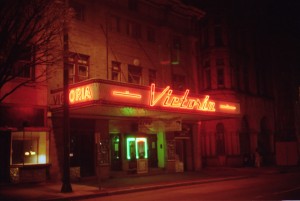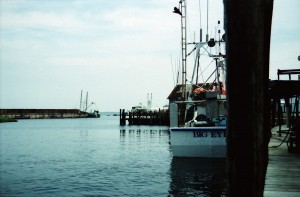Signs and Portents and Stained Glass
Saint Horace Rye is a perfect example of why people continue to search for meaning–or if not meaning, than evidence of something more than plain everyday squalor–in Shantytown. It’s a persistent myth, and the extent to which people talk about it is inversely proportional to the extent to which people believe it. Something significant is destined to happen in Shantytown. Everybody knows it, nobody knows what it is.
There was a time when, for a breathless moment, people thought they had it, whatever “it” was–in the year of the Ilford-Mapp riots, when Creve Coeur became a monument, pilgrimage site, and war zone all rolled up in one little ten-block chunk a few streets in from Shantytown’s waterfront. It was a good guess that lasted nearly thirteen months, but despite historians’ seemingly compulsive need to write about the poet and the musician who collaborated nearly a century or as many as two hundred years apart, when the riots died down, the violence dwindling like the slow drying-up of a river, Shantytown waited, breathless as it ever was.
Whatever they might have been, and they were many things to many people, the Ilford-Mapp riots still weren’t…well…”it.”
I have lived in Shantytown for better than a year, nearly as long as the riots themselves did. The sense of something coming is palpable, if hard to explain. I suppose the easiest exemplar to cite is a certain pervasive tendency to ascribe a portentiousness to things and to interpret endlessly, from actuaries who read like swirling tea leaves the whorls of iron and the ever-chipping brick of the old facades to the cadre of philosophers who see in Shantytown the truest roots of Nagspeake, and claim a pseudo-history for this district that has few points in common with the accepted past of the city. The tendency is alive and well in Creve Coeur as anywhere in Shantytown. The bricking-in at St. Horace Rye was doomed to cause a stir.
If this was any other city, I’d launch here into the history behind the story I’m going to tell: the tale of St. Horace, the building of the Basilica, the centuries of wasted portents witnessed from its perch on Heartbreak Street, the highest point in Shantytown. This being Nagspeake, however, records are sparse at best. St. Horace Rye certainly pre-dates most of Nagspeake, unless the aging of the stone is yet another trompe l’oleil feat by the same artists who painted so many of the oldest buildings in Shantytown, creating elaborate false facades on smuggling warehouses to make them look like hotels, bawdy-houses, restaurants, saloons, and markets. One can absolutely imagine the same obsessive illuminators painting waterstains, cinder and ash marks, all manner of age and decay onto otherwise pure and pale limestone of the basilica. One thing is certain: St. Horace Rye looks ancient, all except for the brand-new brick covering the entrances and every one of the fifteen stained-glass windows, including the huge rose window at the front. The bricks look brand-spanking-new, the cement between them pristine and near-white, which makes perfect sense because they were cemented into place only last year in the course of one night.
And, of course, no one knows who did it.
I have seen pictures. Once upon a time–less than twelve months ago–the stained glass of St. Horace Rye was really a marvel. When you see images of the light flooding into the basilica, falling onto the pews, pouring onto upturned faces it’s clear the panes were works of art. They were made by Lowell Skellansen, an artisan who worked out of the Printer’s Quarter, in a shop that has stood empty for some years. Skellansen also crafted the beautiful triptych of panels over what used to be the altar at the Maltese Cross, the limestone church that’s now a theatre in the Printer’s Quarter. These were designed to be lit from behind and below, as there are no actual windows on the main wall of the chapel, and they are illuminated even today by the original panel of three short Jablochkoff candles from the 1870s. They picture images of the Ark of the Covenant: the crafting of it, the placing of it in the Tabernacle, and the removal of it to Ethiopia. Nothing weird, nothing subversive (the subject matter was, by all accounts, commissioned by the chapel’s governors; it wasn’t a statement of Skellansen’s personal beliefs). But beautiful. Really beautiful. It’s hard to explain, as I’m not a stained glass enthusiast in general. Maybe there’s terminology; I don’t know it. I just know that, from a layman’s perspective, Skellansen glass is to every other piece of stained glass I’ve ever seen as, say, really good animation, Miyazaki-caliber animation, is to the Sunday comics.
When the bricking occurred, the first theory floated was that some mad Skellansen collector had absconded with the windows. Skellansen himself had left Nagspeake years before, but he disappeared altogether from his public at roughly the same time the windows were bricked over, driving the value of his work skyward. Today his glasswork is collectible on the scale of Tiffany glass, even more so in Nagspeake, the only city to have not one but three buildings with Skellansen windows. But at the time of the bricking-in, the church fathers were afraid to pull the bricks out, because they appeared to have been laid within a hair’s breadth from where the windows should’ve been–if the stained glass was still intact underneath, removing the brickwork could’ve done significant damage. Irreparable damage, too, considering Skellansen himself was not returning phone calls from wherever he’d gone.
As it turned out, not only the windows but every entry into the basilica had been bricked over. For some days the basilica was a fortress, resisting all attempts at entry. It took following the smell to find a way in. Father Crescia, an amateur brewer and vintner (brother of Peter Crescia, who runs the brewery at the Drunken Screw), had been working on a liquor that changed hue from a near-colorless crystal to deep red for a church masque in which water was to be turned spectacularly into wine. Grapes were uncooperative; yeast worked better so he decided to make beer instead. In the days when no one could get into the church, Father Crescia’s yeast went berserk. It crept up from the stills below the altar, ranged through the sanctuary, flowered through the nave and clerestory. And then it stopped, and froze, and then, for some reason, certain patches of yeast changed color just as Father Crescia had been training it to do. And that’s when someone followed the scent of yeast to the one remaining ingress into the basilica and found the picture drawn by light and time and yeast on the back of the nave.
Even if you have never used a pinhole camera, the technology is pretty simple to understand. You need an otherwise light-sealed box with a single hole, that’s all. The hole is the lens, and leaving out a bunch of advanced optics, if the circumstances are right, light reflects off of something outside the box, passes through the hole, and creates an image on the back wall of the inside of the box. The bricking-in of St. Horace Rye turned the basilica into a giant pinhole camera. The camera took exactly one picture. Thanks to a batch of photoreactive brewer’s yeast gone wild, it even managed to be in color.
About ten feet up the front facade of St. Horace Rye, just above what had once been the main doors, there is a hole. It’s not an accidental hole, that much is obvious; it looks like it was put there with a wide-bore drill. Whether or not it was there before the bricking-in is anybody’s guess, but now it’s the only opening into the basilica. If you climb a ladder and look inside and allow your eyes to adjust, you can just make out, on the opposite wall at the back of the nave, a tall, dark smudge, vaguely human-shaped, atop a long thin line. And then, if you look, you’ll see what that smudge is.
It’s an image of a man hanging from the neck by a rope, turned upside down because that’s what happens when light is reflected into a box through a pinhole. And if your eyes are properly adjusted, you will even see that the image is drawn in false color, the result of Father Crescia’s yeast caught creeping across the wall at just the right moment, the moment when the image of what must be called an execution (if not a murder) was captured. The yeast in its out-of-control climb across the nave changed color in the varying wavelengths of light reflected from the subject of the photograph, taking on the colors that tint the weird picture. That they froze or died and kept those colors is probably due to a chemical used in the manufacture of the altar candles, which have been reported to sublimate under certain conditions into volatile gases (resulting in several recalls, according to a spokesperson at Deacon and Morvengarde). So the photograph itself, uncanny though it seems, has an explanation. The identity of the hanged man, however, remains as much a mystery as that of the bricklayers who covered Skellansen’s windows.
Who is the hanged man? Why was he killed? And when could such a thing have happened?
The last question is the easiest answered, thanks to the amount of light that would’ve been necessary to create a pinhole image in the basilica. The bricking-in of the basilica was reported the day after the vernal equinox; so sometime in the days when the sun was in the sky the longest, someone was hanged out in front of the basilica, in plain view, and was left there after his death (he had to be still for such a relatively crisp image to have been taken) for long enough, some hours at least, but probably longer. And portentious, watchful Creve Coeur saw nothing.
As to the who and why: everyone has a theory around here, ranging from ghosts to aliens to righteous murder juries, and here’s my favorite; as far as I can tell, it’s the only one that ties the two events (the bricking-in and the hanged man’s photograph) together. It hinges on the third set of Skellansen windows in Nagspeake, which happen to grace the walls of the Oxford Dining Hall at the Shutter Club Mansion on the Slope.
I have been lucky enough to see those windows, too. They are, if it’s possible to say such a thing, the most beautiful windows I’ve ever seen. The glass is tinted in tones of sepia, warm browns, chocolates and shades of pearl that have the feel of black-and-white but with so much more warmth. There are eight windows in the Oxford Hall; six depict moments in the history of photography and two show images of the Shutter Club in the 1920’s. One pictures the famous Sepia Ball, given in honor of the producers and stars of the serial The Emprises of Evangeline. Several segments of the serial, in whish Evangeline is a touring violinist with an uncanny past, were filmed in Nagspeake, including a sequence filmed in the Shutter Club Mansion itself.
The many stories that arose after the Sepia Ball have been told elsewhere, ad nauseam; anyhow, only one concerns this column. There were rumors of some fairly grisly goings-on in other parts of the Mansion during the Ball that resulted in the death of a girl, one of the “moderns” who were frequent attendees of Shutter Club events. Supposedly the only actual witness to the event (the only one who wasn’t a Shutter Club member, that is) was another modern known only by a pseudonym (many girls who visited the Mansion used them, not wanting the things they might have done there to follow them down the Slope into their normal lives). If anybody knew the witness’s real name, it’s never been reported, and she herself has never spoken publicly of the event. She may even never have existed; the only print report of the event was a poem published under the name Hiram Jinks (Hijinks?), and the character Jinks claims witnessed the event and reported it to him may have been invented.
The stained-glass panel depicting the Sepia Ball is all glamour and elegance with the exception of a small figure in one corner. She is so well-hidden among the beautiful faces and gorgeous gowns and tuxedos that she’s almost impossible to see, except at a certain time of day when the afternoon sun hits the window picturing Louis Daguerre on the opposite side of the hall (exactly across from the Sepia Ball window) just right. When that happens, a beam of light is concentrated–and this is where you have to just sit back and wonder at the genius of Lowell Skellansen–through the stained-glass lens of the camera in Daguerre’s hand, and that concentrated beam falls like a spotlight on a tiny, terrified figure fleeing the party: a modern whose white-knuckled hand clutches a Brownie camera.
Whether or not there is any connection between Skellansen and Hiram Jinks, or between Skellansen and the girl in the glass, I have no idea. But I’ve read Jinks’ poem, and there’s no mention in it of the witness having a camera. Skellansen’s window is the only place I have been able to find that makes any mention of that camera, which, if there’s any truth to the image, might make Skellansen the only person, other than the witness herself, who knew of its existence. It would make Skellansen a witness, of sorts, to the camera if not the event. One can only speculate about what images that camera might have recorded.
Which brings us neatly back to the photograph in the nave of St. Horace Rye and the identity of the hanged man, and that of his killers.
Whether or not the two events were linked, it cannot be argued that St. Horace Rye was turned into a pinhole camera, and someone was hanged before the church, his body lined up so as to be reproduced photographically in the nave of the basilica. No one could’ve anticipated the tinting of the yeast, but one could certainly anticipate, would in fact have to have planned, the photograph itself. Someone, or several someones, who could calculate the amount of light and the time needed to take the picture. And from the vantage of the pinhole, you can just tell, if you strain, that the windows were bricked up on the inside, as well as the outside–an unnecessary gesture if the only reason for the masonry was to kill the light. Someone wanted to silence Skellansen’s windows, too. Which makes me think it isn’t too much of a leap to think maybe it was Lowell Skellansen who was hanged before St. Horace Rye. And maybe the photograph in the nave is a message to the girl with the camera. Maybe someone wanted to tell her that no matter how much time may have passed, some pictures are better left undeveloped.
In any case, thanks to that Shantytown tendency to seek meaning, St. Horace Rye is still sealed up, with the exception of a little passage Father Crescia has opened up for purposes of maintenance, and to turn on just a little illumination. You can go yourself and rent a ladder from Skip’s Hardware a little ways down Heartbreak Street, and Father Crescia will insist on holding the ladder for you as you climb up, swing aside the keyhole cover that was made to cover the hole in the wall to protect the photograph (Father Crescia thinks it’s the image of St. Luke the Martyr, and plenty of Shantytowners agree), and have a look for yourself. Is this “it,” the otherworldly visitation of a saint that will once again make Creve Coeur a pilgrimage site, maybe permanently this time? Or is it the clever murder of an artisan, signed with a flourish by those who committed it?
Hard to know, but definitely worth the trip.
Kate Milford is a regular contributor to Nagspeake.com, and is very quick about getting coffee when we need it. Her first book, THE BONESHAKER, comes out in May 2010.
Coming soon…using her inner city-honed breaking and entering skills, Kate takes us to the abandoned cobblestone paths of what was once the happiest place in Nagspeake: FantasyTowne Amusement Park.









